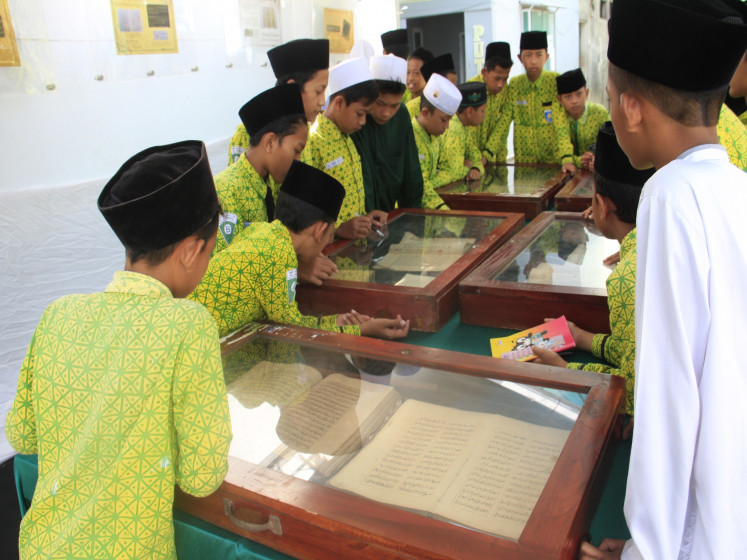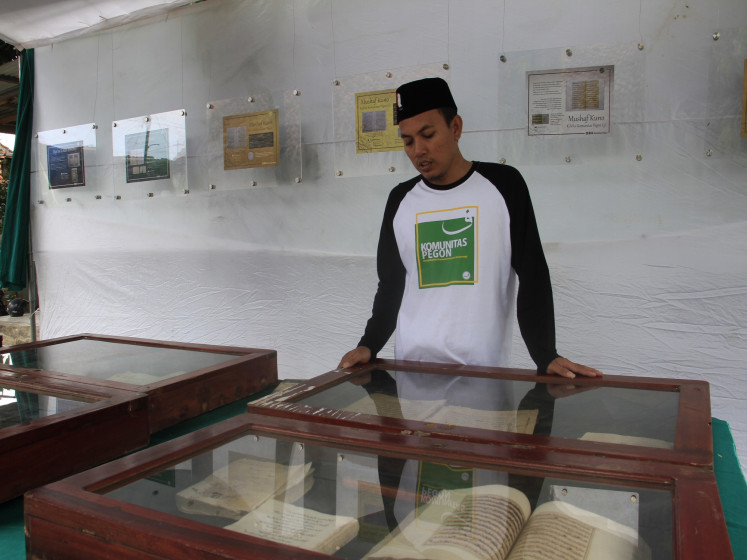Popular Reads
Top Results
Can't find what you're looking for?
View all search resultsPopular Reads
Top Results
Can't find what you're looking for?
View all search resultsPegon: a Javanese script of acculturation and resistance is fading
Change text size
Gift Premium Articles
to Anyone
An Arabic-Javanese writing system used by scholars during wartime is at risk of being forgotten.
Pegon is an Arabic-Javanese writing system that was used by Javanese Islamic scholars during Indonesia’s colonial resistance. Pegon manuscripts, which are mainly kept in pesantren (Islamic boarding schools), documented the development of Islam in Indonesia along with local religious cultures at that time.
Like many other scripts, Pegon is inclusive in its use. However, since Pegon was derived from the Arabic script, its identity is inevitably tied with Islam.
"Now people use the Latin script [more often], while Pegon is only used in [some Javanese] pesantren. So, the fewer people enroll in pesantren, the fewer people that can read and write Pegon," said Ahmad Rosidi, a 40-year-old preacher at Madrasah Diniyah Ar-Rochmani, in Wonogiri, Central Java, who has been teaching Pegon since 1999.
Miftahul Ma'rufin, a santri (student at an Islamic boarding school) from Pesantren Hudatul Muna Dua finds that the number of people interested in studying Pegon is dwindling. "This is because many [religious] books have been translated into Indonesian [and] many find it easier to study."
To prevent further fading of Pegon, Komunitas Pegon (Pegon Community), which formed in Banyuwangi, East Java, has been engaged in researching, documenting and publishing the historical treasures since Aug. 8, 2017. The community is also carefully studying and digitizing its collection of ancient manuscripts.
"We work with many organizations, including with Dreamsea [in 2019], Litbang Agama [Religious Research and Development] in Semarang [in 2020] and soon with the British Library’s EAP [Endangered Archives Program]," said Ayung Notonegoro, an activist from Komunitas Pegon.
In addition, the community has joined the Indonesian Internet Domain Name Manager (PANDI) to register the script in Unicode. Ayung explained that this was done so that in future "the Pegon script can be equivalent to Latin, Arabic and other scripts available in various digital formats."
Select few: Due to the dwindling rate of pesantren enrolment, many fear that Pegon reader and the knowledge will extinct. (Courtesy Pegon Community) (Personal collection/Courtesy Pegon Community)Acculturation
Pegon was born out of acculturation, adaptation and the acquisition of Islamic faith by the Muslim pioneers in Java. It is estimated that religious scholars first used the script around the turn of the 15th century — when the spread of Islam across the island under the Wali Songo (the nine saints believed to have brought Islam) was at its peak.
"We believe that the history of the development of the Pegon script coincided with the development of pesantren [as an institution] in Java," said Alfan Firmanto, a junior researcher in the field of religious literature at the Research, Development and Training Agency of the Religious Affairs Ministry.
The 52-year-old researcher hypothesizes that the script was part of the da'wah (Islamic proselytization) strategy of the ulema to introduce the values of Islamic teachings in Java. "Islam [arrived] in Java when the Javanese people [had adopted] the Kawi [Arabic-Malay] and Javanese scripts in their writing tradition."
To avoid the fading of one culture, a bridge that was the Pegon script was born. The writing system uses modified Arabic characters to write Javanese. "[It is similar to] the Jawi script which is spread across the Malay Peninsula. There are several script modifications to suit the Malay language, such as the letter 'ain’ with the addition of three dots on it [that is read as] 'nya', which is not accommodated in Arabic," said Ayung from Komunitas Pegon.
The Jawi script was further developed in Java into Pegon by adapting to the Javanese language with additional characters not found in the Jawi script. Through this method, the expectation was that the teachings of Islam could be readily accepted and understood by the Javanese people.
Alive: The Pegon Community works with several institutions to keep the script alive amidst modern civilization. (Courtesy Pegon Community) (Personal collection/Courtesy Pegon Community)Pegon bravado
Although identic with Islamic boarding school education, Pegon was also used for various other things, including poetry, diaries, letters and official state documents. There was a time when Pegon knew no ethnicity nor religion.
"[Pegon] was not used exclusively for religious matters like fiqh, tauhid or tafsir [Islamic jurisprudence, the Islamic concept of monotheism and scripture interpretation] and the like," said Ayung. "For example, Pegon was used in several letters from the King of Buleleng to governor general Thomas Stamford Raffles in the 19th century."
The script became a vital part of the nation's literary tradition as it played a significant role in the resistance to injustice during the Dutch colonial period. Several historic mullah, such as Kyai Ahmad Rifa'i Kalisalak, Ajengan Hasan Maulani and Kyai Mojo used Pegon to pour their defiance into literary works. The three were later exiled to Tondano, North Sulawesi.
Kyai Ahmad Rifa'i wrote more than 50 titles using Pegon, which are still taught in the Jama'ah Rifa'iyyah Islamic boarding schools in Central Java that he founded.
"Many of the contents of [his] work satirized and criticized the injustice of the Dutch rulers and their accomplices, who incidentally were natives. These [people] were said to be unjust infidels who should not be followed. Among these works are the Book of Tabsyirah, Book of Takhyirah and Syarihul Iman," explained Alfan.
The Dutch did not sit still. They started rapidly introducing the Latin alphabet through the public education institutions established by the colonial government. Thus, the Pegon script began to be marginalized, surviving only through studies in pesantren.
The situation remained unimproved after independence, as the new government of Indonesia established the Latin alphabet as the official writing system for the Indonesian language.
"Then there was the stigma of 'illiteracy', considering everyone who could not read and write Latin letters as 'illiterate' even though they could read and write in Pegon, Javanese and even Arabic," said Alfan. "[It was followed by] the 'eradication of illiteracy' movement in the early days of the New Order, which further excluded the use of the Pegon script in Java."












